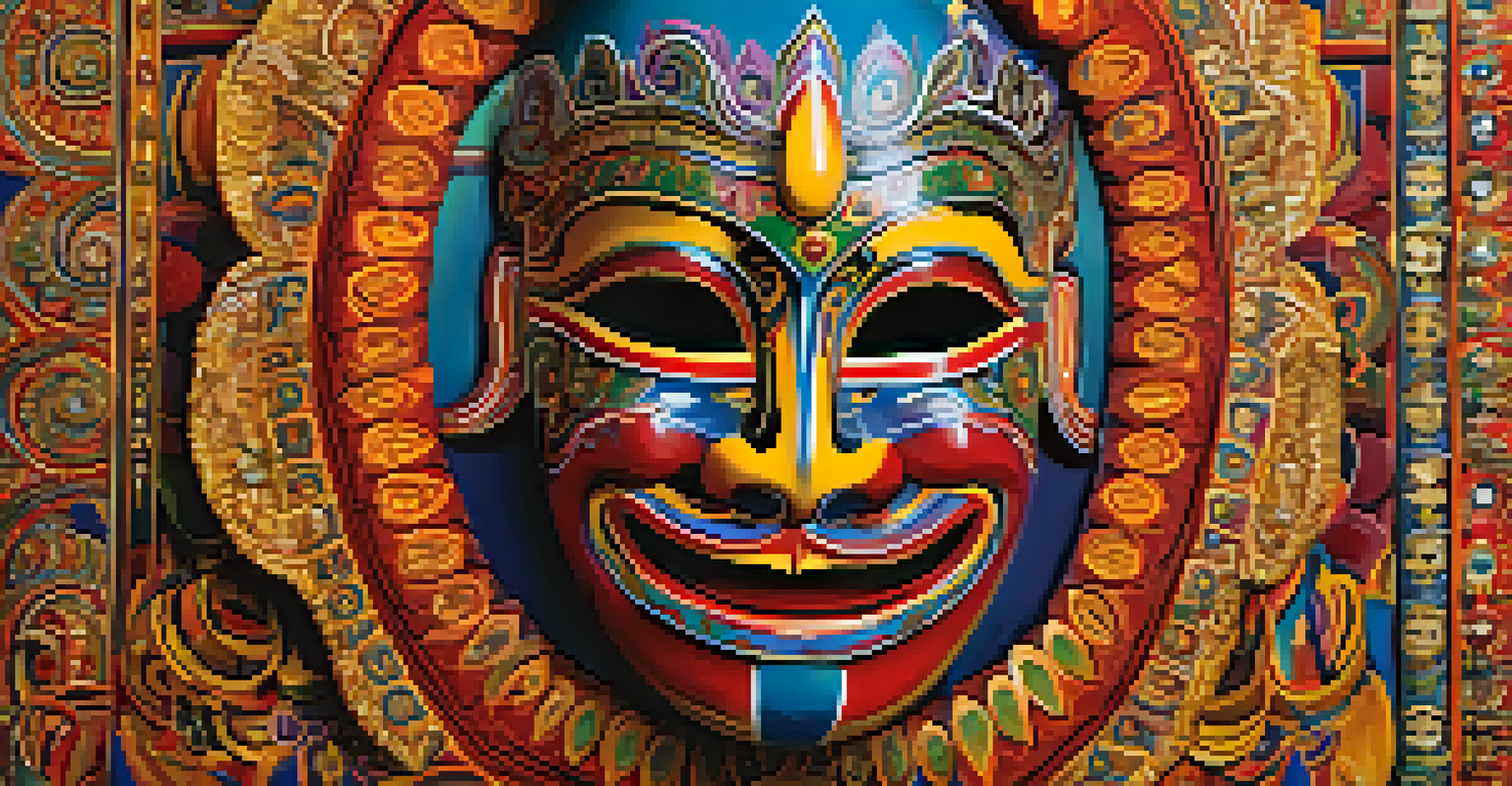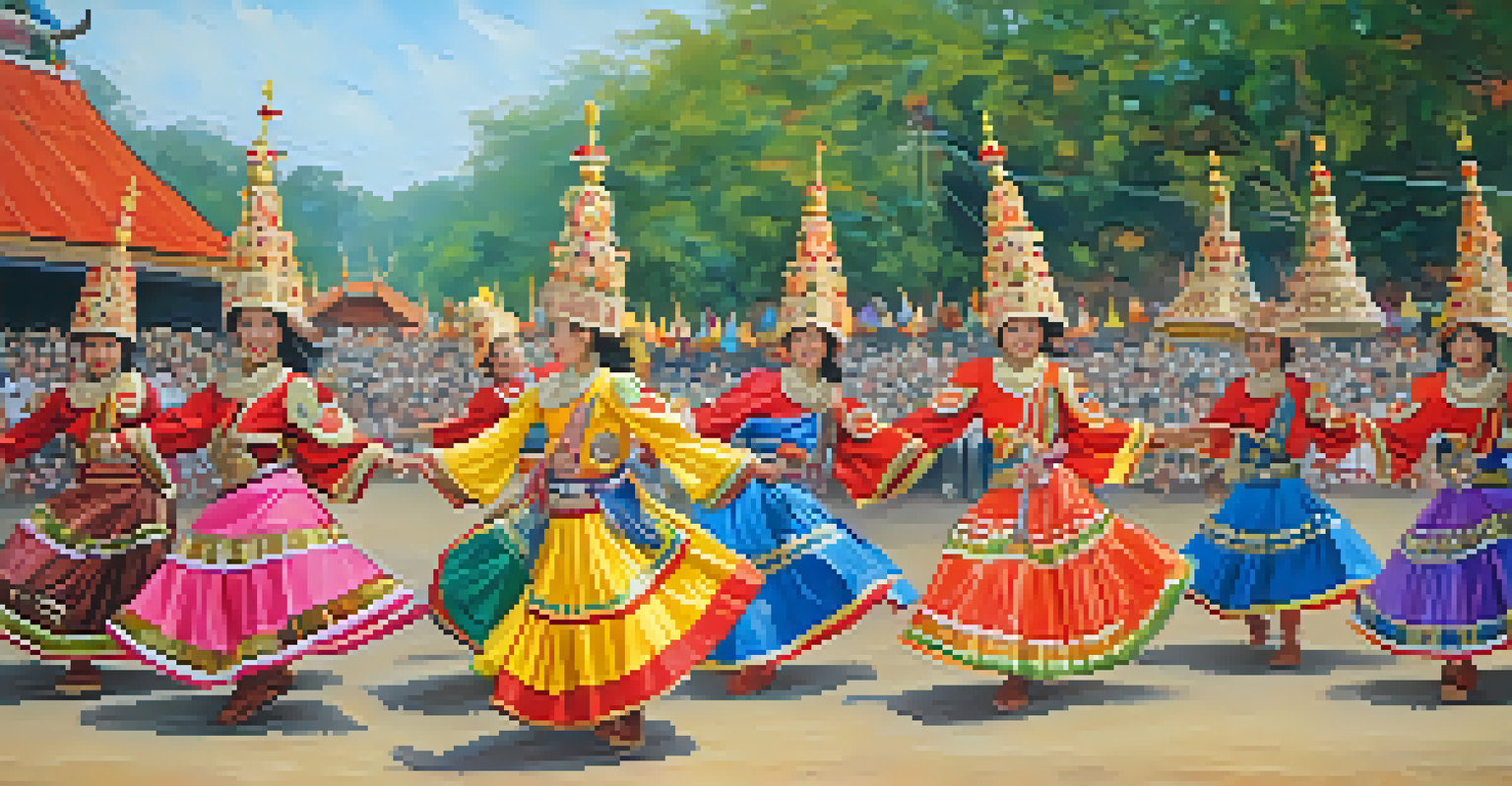The Unique Artistry of the Phi Ta Khon Festival in Loei

An Overview of the Phi Ta Khon Festival in Loei
The Phi Ta Khon Festival, celebrated in Loei province, Thailand, is a vibrant blend of traditional and cultural artistry. Known for its colorful masks and lively parades, this festival draws both locals and tourists alike. It typically takes place over a weekend in June or July, coinciding with the Buddhist holiday of Wan Pha Phum. The event is a celebration of the local spirit and showcases the rich heritage of the Tai Lue people.
Tradition is not the worship of ashes, but the preservation of fire.
At its core, the festival honors the spirits of the deceased, inviting them back to join in the merriment. This unique aspect of the festival adds a layer of depth to the celebration, intertwining the joy of life with the reverence for those who have passed. The colorful processions and traditional dances serve as a reminder of the community's connection to its ancestors.
As you wander through the streets of Loei during the festival, you can feel the excitement in the air. The sound of drums, the laughter of children, and the vibrant visuals create an unforgettable atmosphere. It's a time when the community comes together, sharing stories and traditions that have been passed down through generations.
The Symbolism Behind the Masks
One of the most striking features of the Phi Ta Khon Festival is the elaborate masks worn by participants. Each mask is meticulously crafted from wood or other materials, painted in vivid colors, and often adorned with intricate designs. These masks serve not only as a means of expression but also as a representation of the spirits that the festival honors.

The designs of the masks often convey specific meanings, with each color and motif holding significance. For instance, the vibrant reds and greens can symbolize life and fertility, while other patterns may represent protection or guidance from the spirit world. This artistry transforms the festival into a visual narrative, where each mask tells a unique story.
Celebration of Culture and Heritage
The Phi Ta Khon Festival is a vibrant celebration that honors the spirits of the deceased while showcasing the rich cultural heritage of the Tai Lue people.
Wearing these masks allows participants to embody the spirits, creating a bridge between the living and the dead. As the dancers move through the streets, their performances become a dialogue with the past, celebrating the continuity of life and tradition. This connection not only enriches the festival experience but also fosters a deeper understanding of the local culture.
Traditional Costumes: A Cultural Heritage
In addition to the masks, traditional costumes play a crucial role in the Phi Ta Khon Festival. These outfits are often handmade from colorful fabrics, reflecting the vibrant culture of the Tai Lue people. The designs and patterns used in the costumes tell stories of the community's history and are a testament to their skilled craftsmanship.
Culture is the widening of the mind and of the spirit.
Participants often adorn their costumes with accessories such as bells and other ornaments, adding to the festive atmosphere. When the costumes are paired with the masks, they create a visually stunning display that captivates onlookers. It's not just a fashion statement; it's a celebration of identity and heritage.
The costumes are typically worn during parades and traditional performances, where dancers showcase their skills and cultural stories. This aspect of the festival not only entertains but also educates attendees about the rich traditions of the region. Through the vibrant colors and intricate designs, the costumes serve as a reminder of the importance of preserving cultural heritage.
The Role of Music and Dance in the Festival
Music and dance are integral to the Phi Ta Khon Festival, bringing the celebration to life. Traditional instruments like drums and gongs provide a rhythmic backdrop for the vibrant dances that unfold throughout the event. These performances are not only entertaining but also carry deep cultural significance, often depicting local myths and legends.
As dancers move gracefully through the streets, they engage with the audience, inviting everyone to be part of the festivities. The energy of the music fills the air, encouraging onlookers to join in the fun and celebrate together. This communal aspect of the festival reinforces the bonds within the community and creates a sense of belonging.
Artistry in Masks and Costumes
Elaborate masks and traditional costumes worn during the festival serve as expressions of identity and artistic storytelling that connect the living with their ancestors.
The combination of music and dance transforms the festival into a dynamic cultural experience. It allows participants to express their emotions and stories, creating a shared history that resonates with everyone present. This connection through rhythm and movement highlights the importance of cultural expression in fostering unity and joy.
Food and Festivities: A Culinary Journey
No festival is complete without delicious food, and the Phi Ta Khon Festival offers a delightful culinary experience. Local vendors set up stalls, serving traditional Thai dishes that tantalize the taste buds. From spicy papaya salad to savory grilled meats, there’s something for everyone to enjoy, making the festival a feast for the senses.
Food plays a central role in Thai culture, and during the festival, it becomes a way for people to come together and celebrate. Sharing meals fosters community spirit and encourages conversations among attendees. It’s not just about satisfying hunger; it’s about building connections and creating lasting memories.
In addition to traditional dishes, the festival also features unique local delicacies that showcase the region's culinary heritage. Trying these dishes is an adventure in itself, allowing visitors to immerse themselves in the rich flavors of Loei. The combination of food and festivities creates a vibrant atmosphere, making the experience truly unforgettable.
Eco-Friendly Practices at the Festival
In recent years, there has been a growing awareness of sustainability at the Phi Ta Khon Festival. Organizers are increasingly implementing eco-friendly practices to minimize the environmental impact of the event. This includes using biodegradable materials for decorations and encouraging attendees to reduce waste.
The festival also highlights the importance of preserving local culture and the environment. Educational initiatives aim to inform participants about the significance of protecting natural resources while respecting cultural traditions. This connection between culture and sustainability is vital for the future of the festival.
Community and Culinary Delights
The festival fosters community spirit through shared meals and lively festivities, creating lasting connections while offering a delightful array of local culinary delights.
By embracing eco-friendly practices, the Phi Ta Khon Festival sets a positive example for other cultural events. It shows that celebrating heritage and caring for the environment can go hand in hand. This commitment to sustainability enhances the overall experience, allowing everyone to enjoy the festival while being mindful of their impact.
The Global Appeal of the Phi Ta Khon Festival
The Phi Ta Khon Festival has gained international recognition, attracting visitors from around the globe. This interest highlights the universal appeal of cultural celebrations and the rich diversity of human expression. As more people discover the festival, it serves as a platform for cultural exchange and understanding.
Social media and travel blogs have played a significant role in promoting the festival, showcasing its vibrant colors and lively atmosphere. Images of the unique masks and traditional performances captivate audiences worldwide, sparking curiosity and inspiring travel to Loei. This global attention helps to preserve the festival's traditions for future generations.

Moreover, the festival has become a source of pride for the local community. It fosters a sense of identity and belonging among residents, reminding them of their rich cultural heritage. As the festival continues to evolve, it remains a testament to the enduring power of art, tradition, and community.